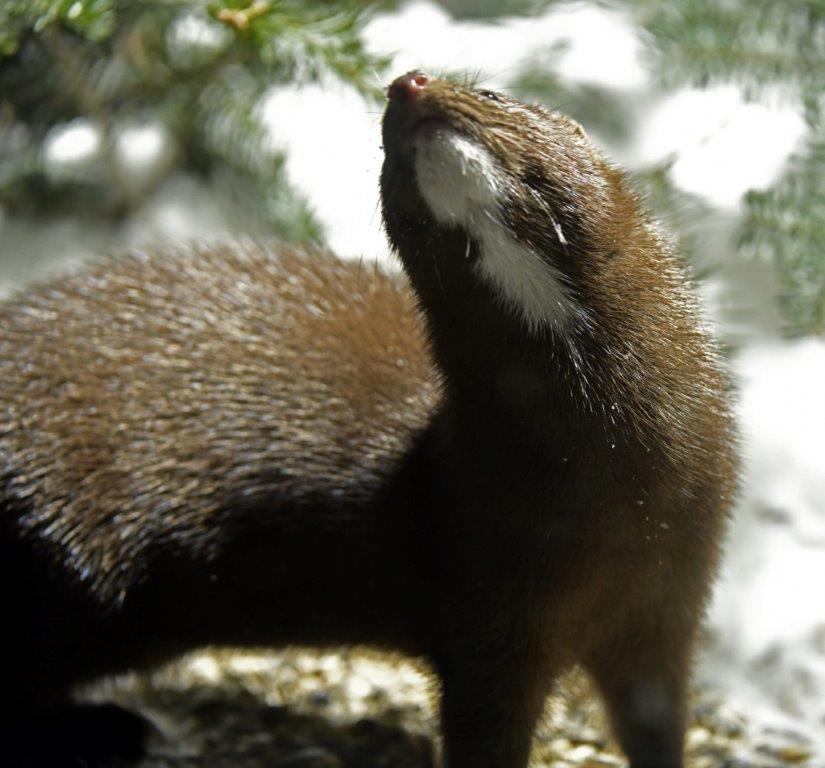Daily Updates
New Mink - UPDATE January 19, 2021
19 January 2021
Print Email
Mink New
Mink New

Mink New
Mink New

From the glimpses we have been getting of its white chin patch, we might have confused this new mink with Spot. I believe this new mink is bigger than Spot, but not enough to notice if we are going by the pure white chin patch that we are glimpsing in part. Usually we see a top or side view and can see only part of the white chin patch.
Today, the mink lifted its head and showed itself to be a mink we had not yet recorded. The patch looks somewhat like the patch of Banjo from March of 2020, but the difference is obvious when you compare the two. I don?t know how long this mink has been confusing us, but it certainly knows the program.
Mink New
Mink New

Mink Banjo 3-4-2020
Mink Banjo 3-4-2020

Yesterday, I sent the following to the DNR about the permit to use radio collars and den cams.
?Dear Dr. Larson,
Hoping the permit to use radio collars and den cams is moving along despite the hindrances of covid and having to work at home. We can be ready quite quickly at this end once we get the word from you. I can?t think of any issues that might complicate the permit and require special conditions beyond the permits prior to Commissioner Landwehr. If there is any problem, please call me at 218-365-4480 or at 218-343-1655(Cell).
No den cam bear has ever abandoned its den or been overly disturbed by my work. When I come to a den, I announce myself, and the bear knows I?m not a moose, wolf, or other animal that would create anxiety.
However, I did think of a non-issue that might be worth explaining. During the hearing of 2014, the DNR showed a video of cubs squawking in a den as I began to crawl in to confirm their sexes. They were squawking because the mother had temporarily left the den to urinate, briefly leaving the cubs without her contact and warmth. Cubs almost always squawk in that situation. It had nothing to do with me; but after the hearing I saw it mentioned in the judge?s decision as me disturbing the cubs.
In fact, cubs of that age do not fear strangers. Newborn cubs in dens are in their 6-week ?critical socialization period? when they accept strangers. The DNR knows that very well. DNR bear biologist Dave Garshelis and his team routinely enter dens to gently and quietly lift the cubs away from the tranquilized mother and pass them to people waiting outside the den to quickly tuck them into their coats against their warm bodies for warmth and security. The gentle handling does not upset them. This practice by the DNR is well known, and hundreds of members of the public have snuggled cubs as part of the DNR?s public education efforts. I?ve done the same. Snuggled in a coat like that, cubs sometimes hum their contentment.
When the video of the squawking cubs played in the courtroom, the DNR said nothing, and I never thought any of it required an explanation, although I did wonder why the sound was turned up to the point of distorting the cries. Apparently the DNR later claimed that the video showed me insensitively disturbing the cubs.
As it turned out, I had hardly started in when Lily returned from urinating, so I backed out of her way so she wouldn?t have to squeeze by me. She doesn?t regard me as a danger to her or her cubs. I wish I would have seen the need to explain this when I had a chance to testify. I hope we can finalize the permit soon for the sake of science, education, and all the factors that the Mayor of Ely has mentioned. I hope that at some point you and I can meet study bears together like I did with former Commissioner Al Garber and Assistant Commissioner Kim Bonde.
Sincerely,
Lynn?
Back to this update: I very much hope the DNR grants the permit and allows us to move beyond being hampered as we have been since 2014. With radio collars, we would be able to follow familiar bears to dens each fall and return to learning how they behave in their hidden worlds. It is the least observed aspect of black bear life. Most of what was in our published paper of July 2020 was new to science, and there is much more to learn.
Thank you for all you do.
Lynn Rogers, Biologist, Wildlife Research Institute and North American Bear Center

 Author
Topic: Jewel and her cubs (Read 2319284 times)
Author
Topic: Jewel and her cubs (Read 2319284 times)
